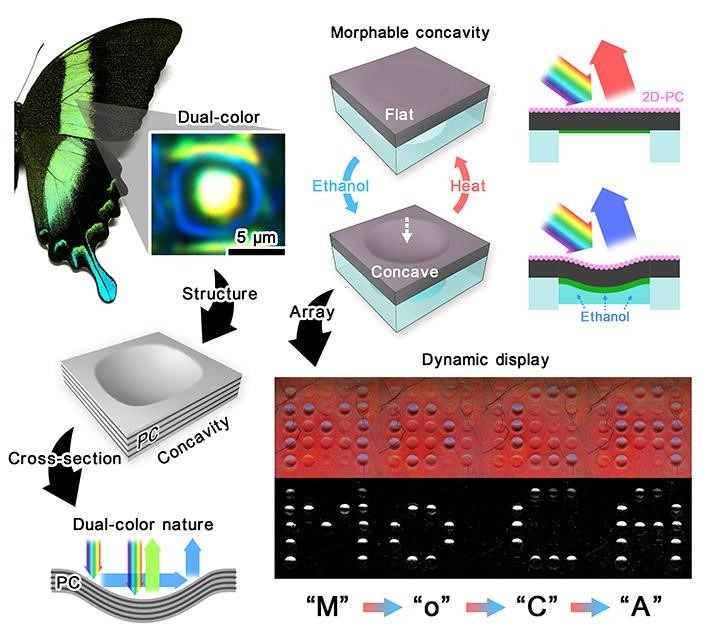HKU Engineering researchers develop a soft colour-changing system that may lead to revolutionary optical devices
HONG KONG SAR - Media OutReach - 25 September 2023 - Researchers at the University of Hong Kong (HKU) designed an innovative pixalated soft colour-changing system called Morphable Concavity Array (MoCA).

Pixelated soft colour-changing systems are malleable structures that, by manipulating light, can change colour. They have applications in a wide range of industries, from medical bandages that change colour if there in a infection, to foldable screens on smartphones and tablets, as well as wearble technology where sensors are itegrated into the clothing fabric.
The research was co-directed by Professor Anderson Ho Cheung Shum from the Department of Mechanical Engineering at HKU, and Professor Mingzhu Li from the Institute of Chemistry, Chinese Academy of Sciences, and led by Dr Yi Pan from the Department of Mechanical Engineering at HKU.
MoCA fabricated by the HKU researchers is a thin (its thickness is about 3 human hairs) rubber-like structure that consists of two layers – the top layer is a photonic crystal elastomer actuator (PC-EA) film and the bottom one is a hole array – a lattice with regularly spaced round holes.
The PC-EA film itself consists of two layers – an elastomer layer (GPDMS) on top and and a hydrogel layer (pNIPAM) below.
If ethanol is added to the pNIPAM layer, it swells, and the resulting tension pulls the elastomer GPDMS layer downwards into the hole in the array, producing a dish-like concave shape called morphable concavity (MoC) that acts as a pixel. After the concavity is formed, the red light is blocked and the visible colour of the pixel changes from red to blue.
MoCA was inspired by the stuctures on butterfly wings called dual-colour micro-concavities that produce vibrant, irredescent colours.
Dual-colour micro-concavities are tiny pits which block certain wavelength of light, producing two different colors depending on the angle of light and the viewer's perspective. On butterfly wings these pits are arranged into a regular structures known as photonic crystals.
MoCA reproduces butterfly wing's photonic crystal, and is revolutionary as the first example of a pixelated colour-changing system that relies on flat and concave structures to produce different colours.
"The colour-changing strategy of MoCA is achieved by changing its local morphology, specifically by controlling the transition between 'flat' and 'concave' states. This sets MoCA apart from other pixelated colour-changing systems," said Dr Pan.
Another breakthrough is that the colour changes in pixels can be manipulated individually, because in MoCA each pixel is connected to an individual "piping system" through which ethanol is delivered.
"We use multi-channel microfluidics to introduce and remove solvents to manipulate MoCA, offering a complementary approach to the conventional electrochromic methods," explained Dr Pan.
MoCA can be used for counterfitting – for example concealing in products, such as clothing, patterns or QR codes that can only be visible under certain conditions. HKU team's long term goal, however, is to use the principles behind MoCA – soft matter and microfluidics, to construct optical devices that mimic, and surpass, the capabilities of compound eyes of insects.
Compound eyes contain multiple light-processing structures and offer several advantages over non-compound vision, such as wider field of vision and the ability to focus on multiple objects at the same time.
Deformation of the crystalline lens in the human eye allows us to focus on different distances, explains Professor Shum. MoCA's technology where individual units can be deformed - made change shape from flat to concave, can be harnessed to create multiple lenses that can change focus individually.
Crystalline lenses have their own adavantages such as greater focusing ability, higher resolution, and better colour perception.
"Optical devices with a combination of the compound eye and the crystalline lens, would not only imitate nature but transcend it," said professor Shum.
The results were published in Advanced Science as "Pixelating Responsive Structural Color via a Bioinspired Morphable Concavity Array (MoCA) Composed of 2D Photonic Crystal Elastomer Actuators."
Declaration: The use of materials from this paper (Yi Pan, Chang Li, Xiaoyu Hou, Zhenyu Yang, Mingzhu Li, Ho Cheung Shum. Pixelating Responsive Structural Color via a Bioinspired Morphable Concavity Array (MoCA) Composed of 2D Photonic Crystal Elastomer Actuators. Advanced Science, 2023, 10, 2300347.) follows the terms of its CC BY 4.0 license (https://creativecommons.org/licenses/by/4.0/) and all materials are used without any changes.
Link to the paper: https://onlinelibrary.wiley.com/doi/10.1002/advs.202300347
Hashtag: #HKU
The issuer is solely responsible for the content of this announcement.

















